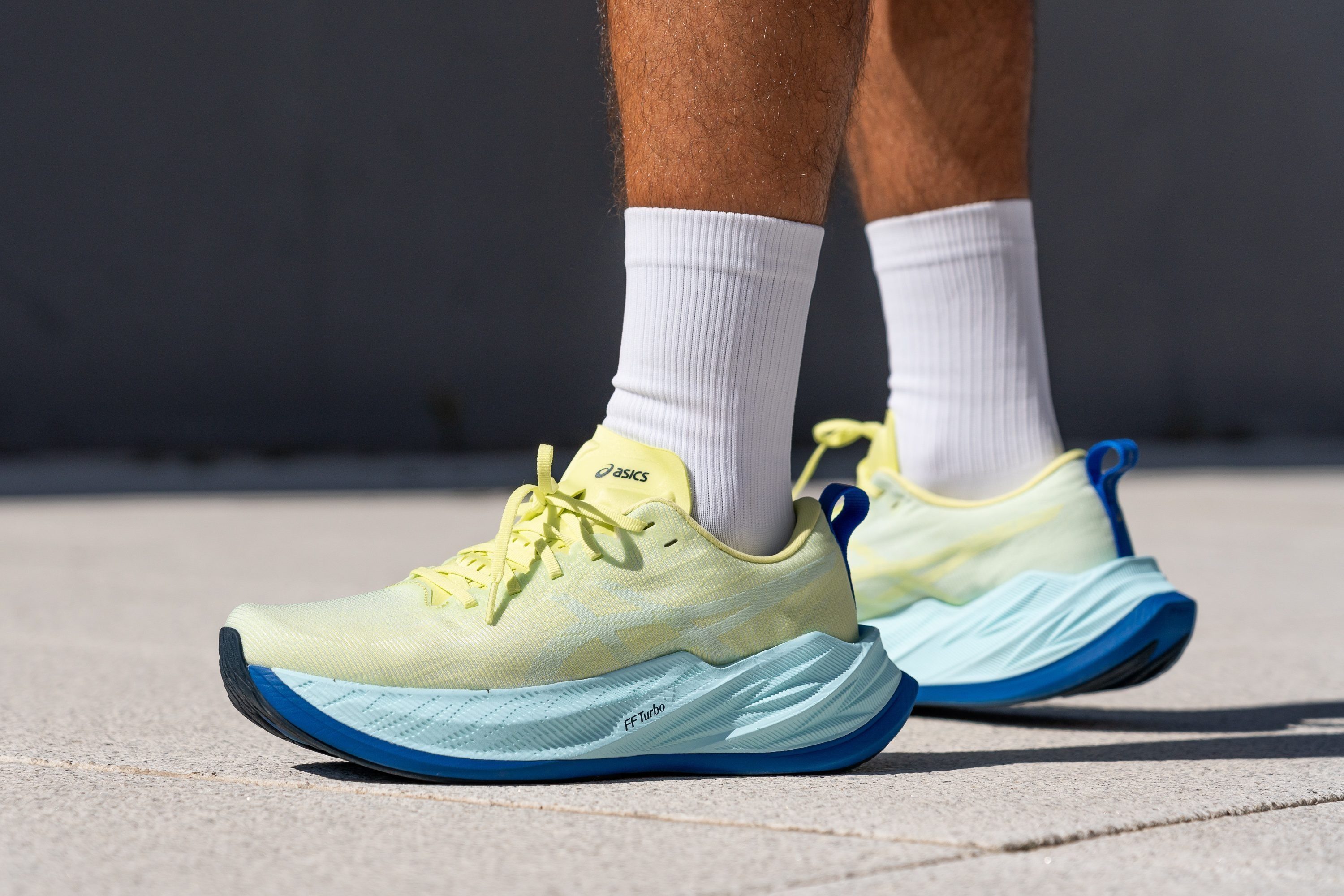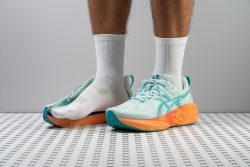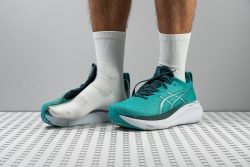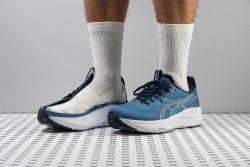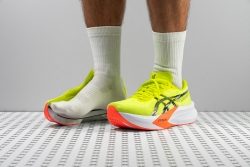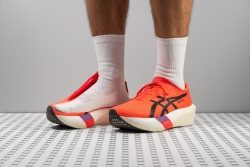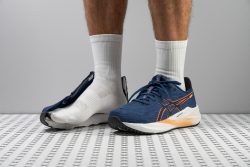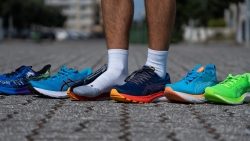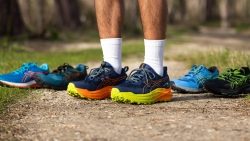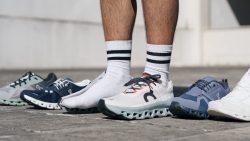7 Best ASICS Running Shoes in 2025
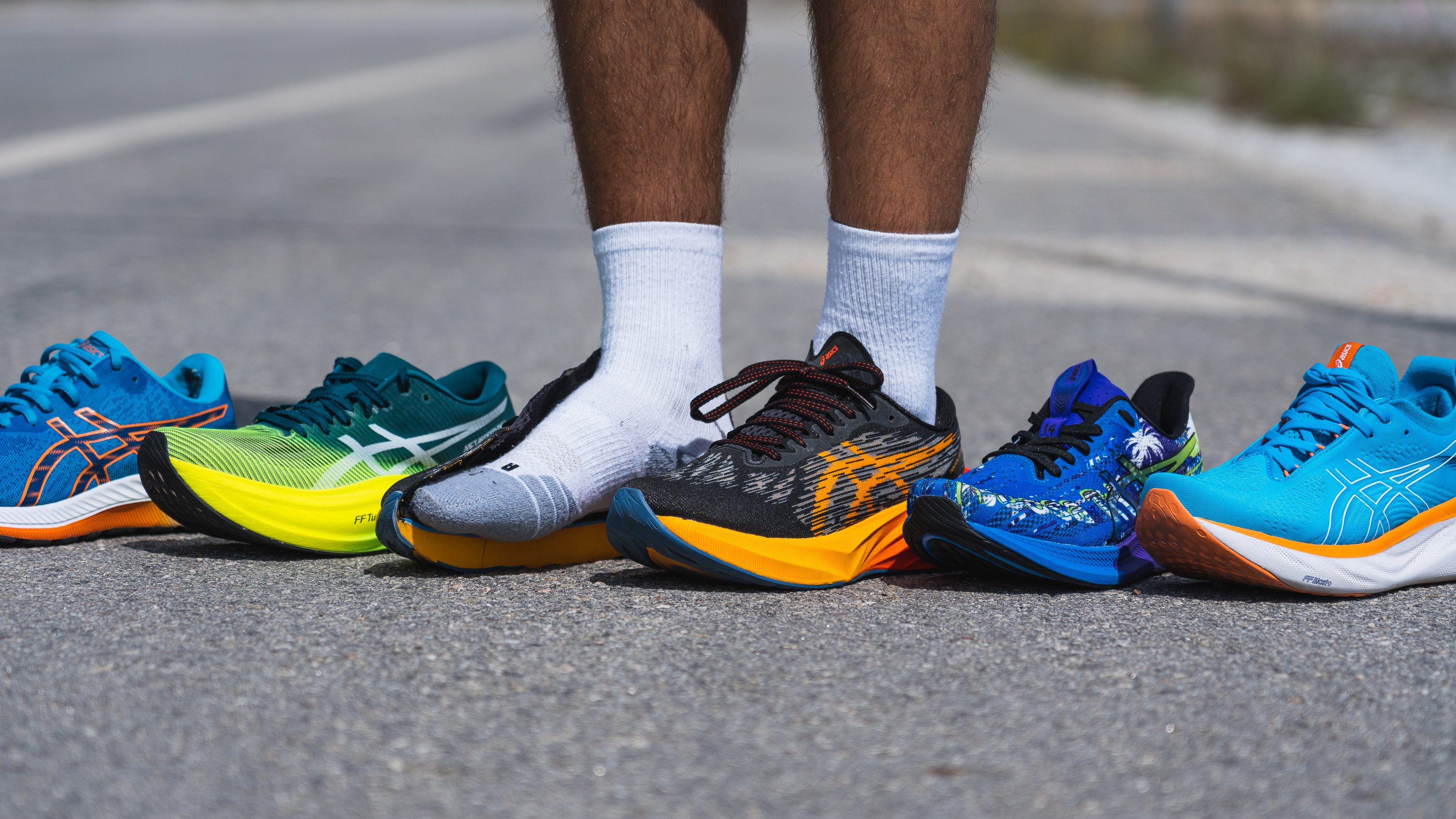
We buy shoes ourselves. We earn commissions when you buy through us, at no extra cost. Why trust us
With such an extensive collection of ASICS shoes to choose from, there are options for all types of runners. Whether you need a comfortable cruiser for long miles, a carbon-plated racer for new PBs, or a stability shoe for overpronation, ASICS has got them all.
And we are here to help you find the best. We have tested all of these shoes in our lab and on the test runs. We wear-test each of them to completely immerse ourselves in what they offer! And we dissect them and measure e v e r y t h i n g. Here are our top picks in different categories.
How we test ASICS running shoes
With nearly 200 ASICS running shoes on the market, our mission is to help you find the best one. We purchase all ASICS shoes with our own funds to keep the reviews honest.
- First, we run with each pair to test and provide comprehensive feedback.
- Second, every ASICS shoe is sliced into pieces in our lab. Ever wondered what a Kayano looks like from the inside?
- We use scales, durometers, callipers, and even a custom smoke machine to measure 30+ parameters. It helps us translate what "durable" and "breathable" look like in numbers.
- We use specalized machines to test energy return, shock absorption, and traction.
Finally, we list the cream of the crop right here.
Best ASICS running shoes overall
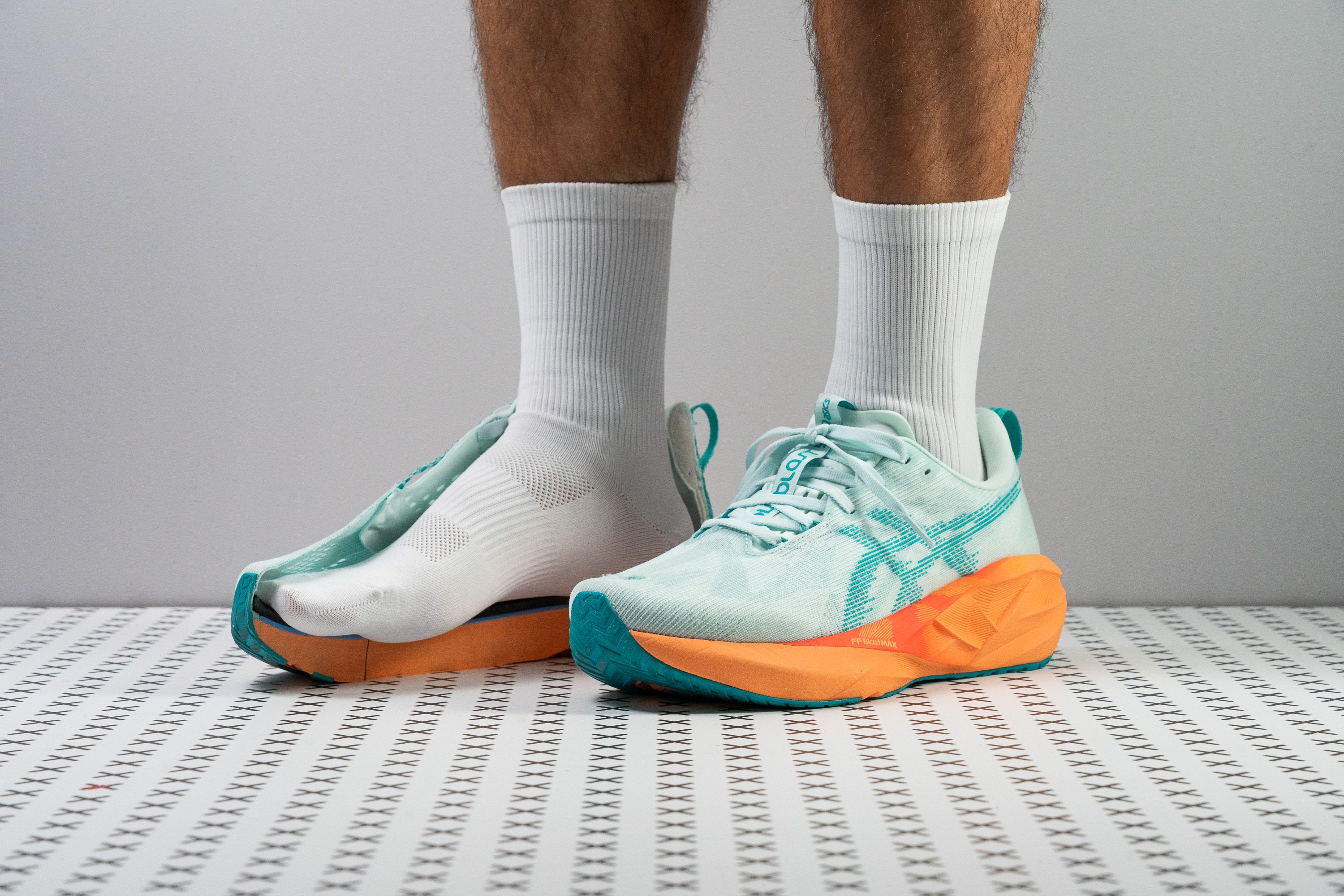























































What makes it the best?
Extensive runs and lab tests back up our decision to crown the Novablast 5 as ASICS’ best running shoe. We experienced a premium level of comfort that doesn’t forego energy return and stability. It merges versatility and reliable durability, making this shoe an exceptional all-rounder that will last.
Our feet feel great at any point in our run since we’re spoiled with a plush cushion that beats the average in terms of height and density. Our durometer confirms it’s 38.4% softer than average while our calliper shows a staggering 40.9/33.5 mm stack height. We enjoyed its bouncy and responsive feel whenever we picked up the pace.
Novablast 5 cleverly adds generous width to its base for confidence-inspiring landings. Our calliper shows a very vast 122.3/97.6 mm landing platform, which is more than enough room for us to maintain our balance. Thankfully, it’s easy to manoeuvre despite its bulk. Our bend test validates it’s 32.2% more flexible than average.
Finally, what seals the deal is its durability. Even after running double-digit miles on tough pavements, the outsole barely has scratches. We couldn’t resist checking with our Dremel and Novablast 5 establishes its longevity by showing less damage than average in our abrasion test.
While this pair performs great overall, it lacks the energy to sustain record-breaking paces. We recommend exploring other options for races.
Pros
- Improved energy return with FF Blast MAX foam
- Plushiest foam in a Novablast yet
- Keeps the same price as v4
- Higher stack height for extra cushioning
- Enhanced flexibility
- Lighter than its predecessor
- Best Novablast ever for wide feet
- Exceptional weight-to-cushion balance
- Works for short, medium and long runs
Cons
- Breathability could be improved
- Toebox durability
- Toebox durability
Best ASICS daily running shoes
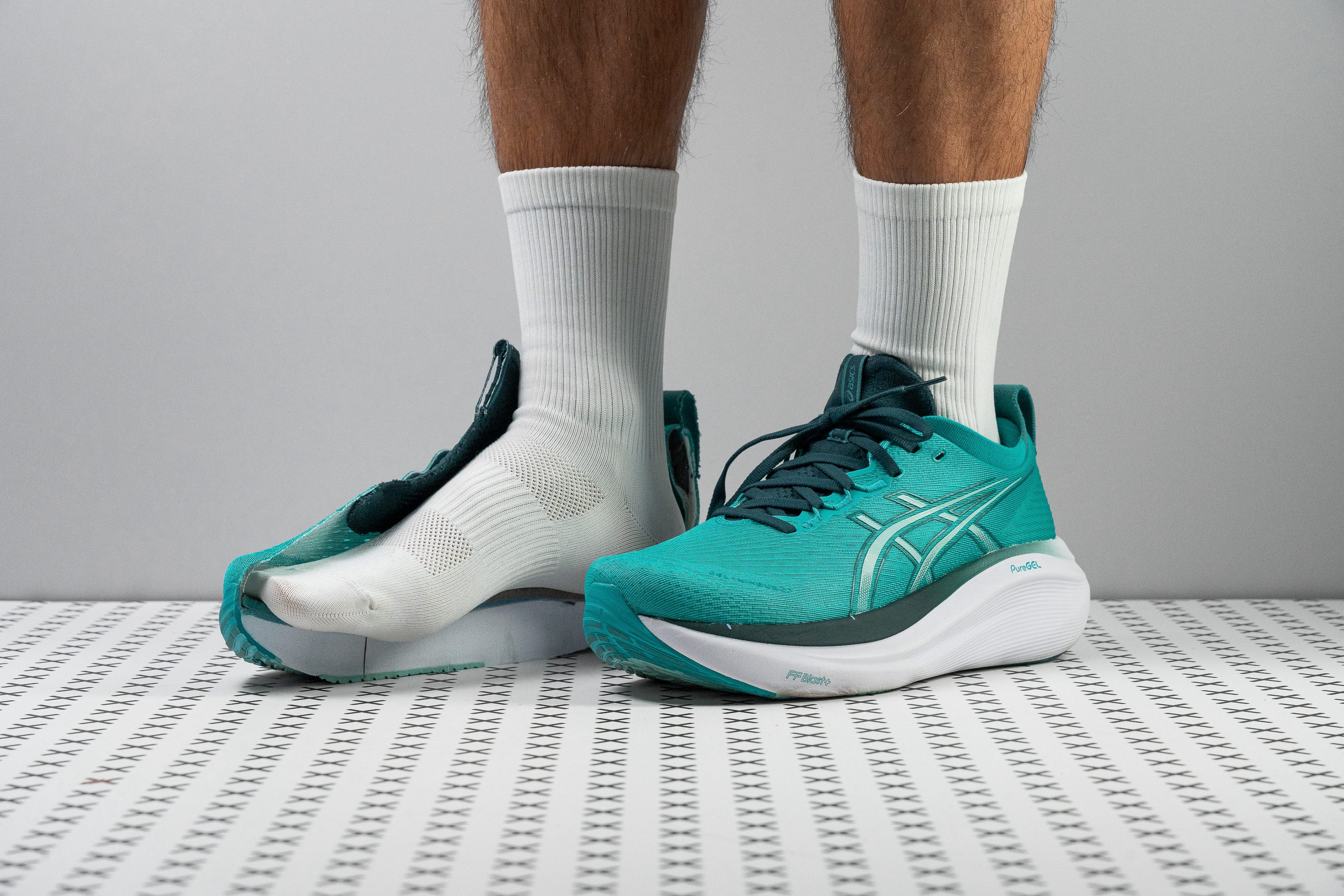


















































What makes it the best?
The ASICS Gel Nimbus 27 offers an unparalleled experience of foot euphoria, thanks to its exceptionally cushioned midsole and surprisingly firm landings. Among the ASICS models subjected to rigorous testing both in and out of the lab, this shoe stands out as the ultimate daily trainer.
The comfort level achieved with the Gel Nimbus 27 is simply off the charts. Our meticulous measurements reveal that its midsole foam is at par with the average at 21.0 HA. Furthermore, its towering stack height of 42.7/34.4 mm boldly surpasses the average by 8.6/8.9 mm, elevating its cushioning to extraordinary levels. Its unparalleled thickness, coupled with the innovative PureGEL technology integrated into the heel, indulged us with luxurious comfort, effectively dampening ground impact even during gruelling endurance runs.
Despite its monstrous height, the Gel Nimbus 27 inspires confidence with every stride, offering stable and secure landings. Its wide base and stiff construction ensure a planted feel, while our manual torsional rigidity assessment awards it a perfect 5/5 rating, highlighting its resistance to twisting forces.
However, it's worth noting that the midsole prioritises comfort over energy return, making it less conducive to faster paces beyond moderate speeds. While perfect for leisurely runs, those seeking more responsiveness should check alternative options.
Pros
- Even more foam underfoot!
- Premium-feel, breathable upper
- Fantastic stability
- Improved toebox with extra wiggle room
- Flexible knit tongue
- True maximalist comfort for recovery runs
- Amazing heel lockdown
- Top-tier grip
- Top-tier grip
Cons
- Feels bulky and heavy
- Minor price increase
- Lacks energy return
- Minimal outsole coverage
Best stability ASICS running shoes
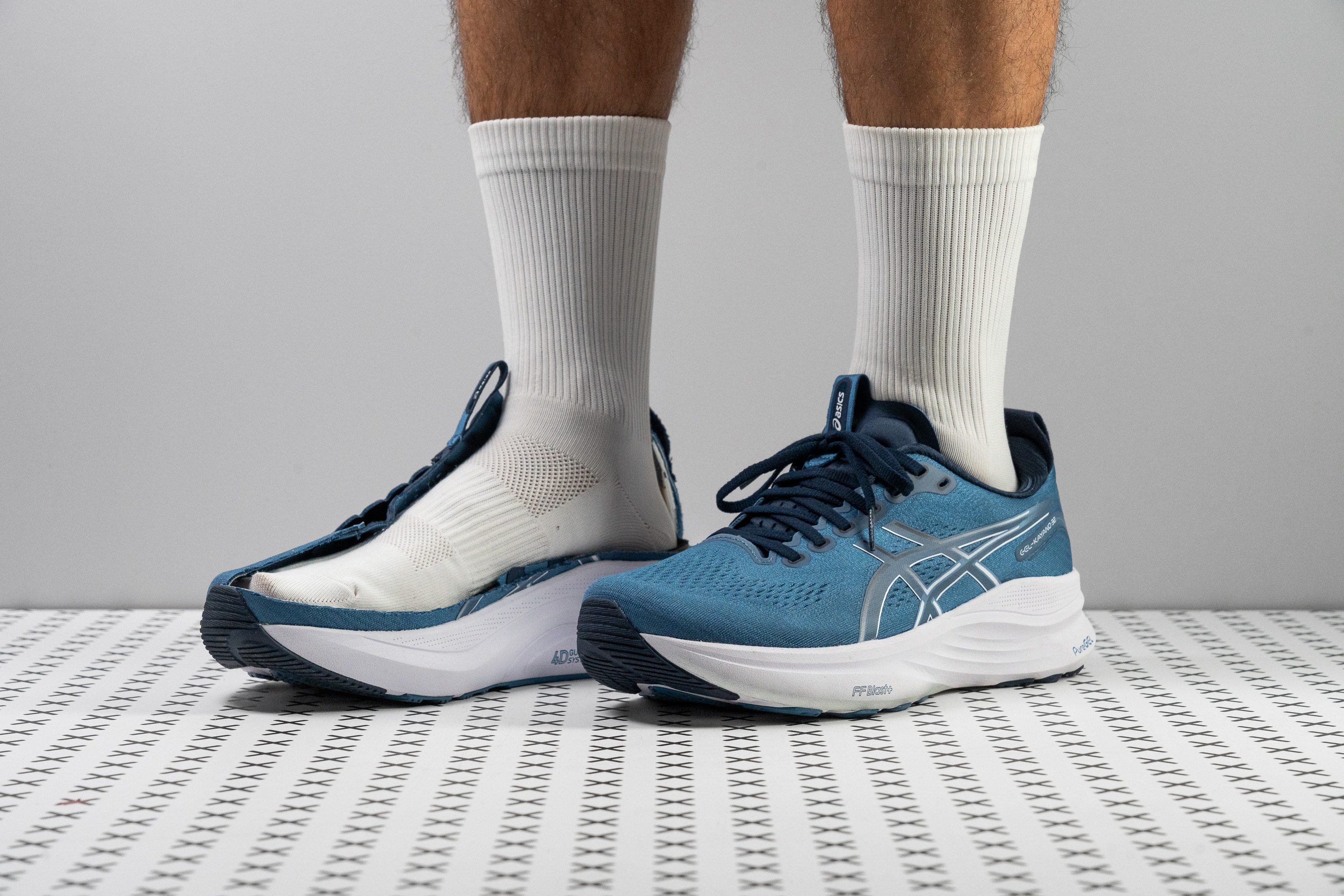













































What makes it the best?
Multiple tests in and out of the lab cemented the Gel Kayano 32’s position as the best ASICS stability shoe. Delivering steadiness and comfort like no other, it cleverly integrates subtle support elements such as the 4D Guidance System while maintaining a pleasantly cushioned ride.
What makes GK32 stand out is its ability to provide adaptive stability through its 4D Guidance System, making use of a softer foam under our arch. With further use, it adjusts to each unique foot shape and movement. Along with the midsole sidewalls and expansive base, we felt confident with each landing. As our calliper shows, the forefoot is a massive 119.8 mm, and the heel is 97.2 mm.
The midsole blew us away with its exceptionally strain-reducing mega-stack. It towers at 39.9/30.6 mm and is made of ASICS’ cloud-like FF Blast+ ECO foam. Testing for shock absorption, the shoe reduces impact better than average, with high scores of 133 SA in the heel and 116 SA in the forefoot.
Unfortunately, GK32 offers low energy return. Those seeking a dynamic ride should skip this pair.
Pros
- Amazing shock absorption
- Plush and breathable upper
- Made to last
- Dependable for most pronators
- Heavy-duty outsole with excellent grip
- Stable as a table
- Pillow-soft heel padding
- Improved fit
- Excellent build quality
Cons
- Not for soft-foam lovers
- Bad energy return
- Overpriced in Europe
ASICS running shoes with the best shock absorption
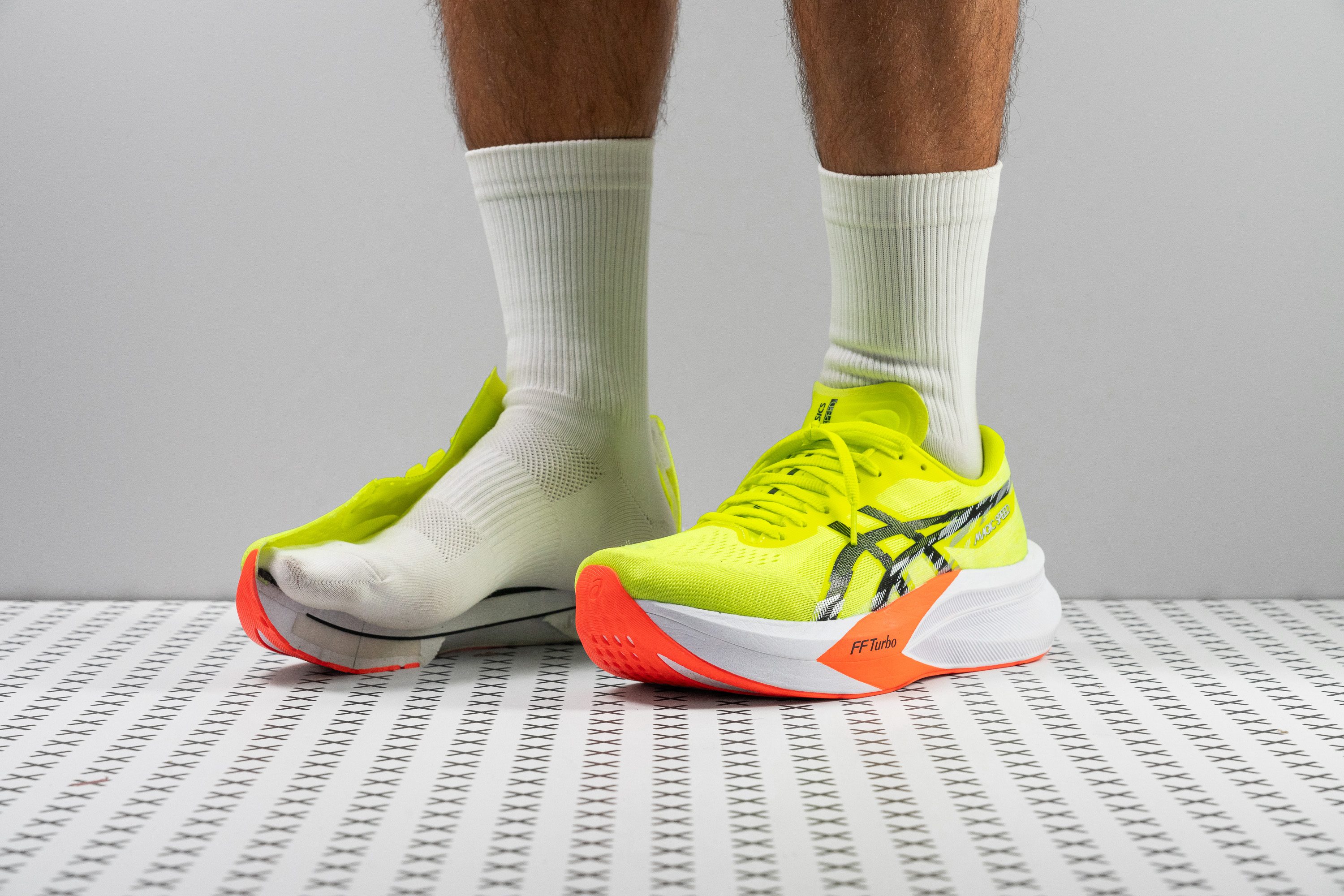


































































What makes it the best?
Combine joint protection, height, superior breathability, and a touch of spring, and we have the ASICS Magic Speed 4. It allowed us to delight in lasting comfort during our runs, offering the best shock absorption among ASICS running shoes, proven by our feet and lab results.
All types of runners will enjoy maximum protection as we measured a massive stack height of 42.5/32.9 mm. In terms of shock absorption, we recorded solid scores of 144 SA in the heel and 122 SA in the forefoot, offering a cushy sensation underfoot that shields us from landing impact.
MS4 integrates the bouncy FF Turbo foam in the forefoot, and our results from the energy return test confirm its presence with a high 61.8% score! The midsole also features a curved carbon plate, which enhances a propulsive ride. In our bend test, MS4 emerged 76.7% stiffer than average!
To ease off some steam, the upper offers unobstructed airflow. MS4 doesn’t trap heat at all and received the maximum 5/5 breathability rating in our smoke test.
While still lightweight at 8.4 oz (237g), the fourth version gained some weight and is still quite heavy compared to supershoes. Those who value weight savings for racing should go for a sub-8-oz shoe.
Pros
- Enhanced midsole
- Exceptional grip
- Superior durability
- Awesome traction
- Excellent value for a supertrainer
- Colossal cushioning
- Carbon plate!
- Ideal for marathon-paced workouts
- Fantastic upper
Cons
- Limited stability
- Low bounce
- Narrow fit
ASICS running shoes with the best energy return




















































What makes it the best?
After miles of heart-pounding and adrenaline-filled runs, we determined that the Metaspeed Edge Tokyo is the ultimate ASICS running shoe with the best energy return. One of the most exceptional supershoes in our lab, it’s designed to deliver winning performances and personal bests. Its plush yet energetic midsole steals the show, further enhanced by its ultra-light and highly-ventilated experience.
The Metaspeed Edge Tokyo proves it’s an elite performer with its curved carbon plate below the FF Leap foam. Every compression under our feet translates to a substantial rebound that makes us feel like gliding through the miles. With exceptional energy return scores of 78.7% (heel) and 76.8% (forefoot), its propelling nature is undeniable!
The comfort we experienced during testing was truly remarkable. The midsole saves our legs from impact and fits just within the race-legal 40-mm limit with its 38.9/32.0 mm stack. Each landing feels highly cushioned, allowing us to race even up to marathon distances. Our shock absorption test proves this with high scores of 146/132 SA.
Despite being a maximalist, the shoe is a weightless 5.6 oz (159g), significantly lighter than the 7.3 oz (207g) average race shoe in our lab. In our breathability test, the upper allowed smoke to pass through with such ease that it seemed to envelop the shoe almost instantly, receiving the highest 5/5 mark.
However, it’s worth noting that this ASICS racer costs £270. Those who prefer trying out a more affordable shoe can search for alternatives.
Pros
- Light as a feather
- Excels at any distance, from 5K to the marathon
- Elite-level traction
- New FF Leap midsole is super responsive
- More stable than the Metaspeed Sky Tokyo
- Plush forefoot
- Excellent upper
- Classic rolling feel from curved plate
- Better than Metaspeed Edge Paris in every way
Cons
- Price increase
- Narrow fit
- Not stable
Best ASICS supertrainers
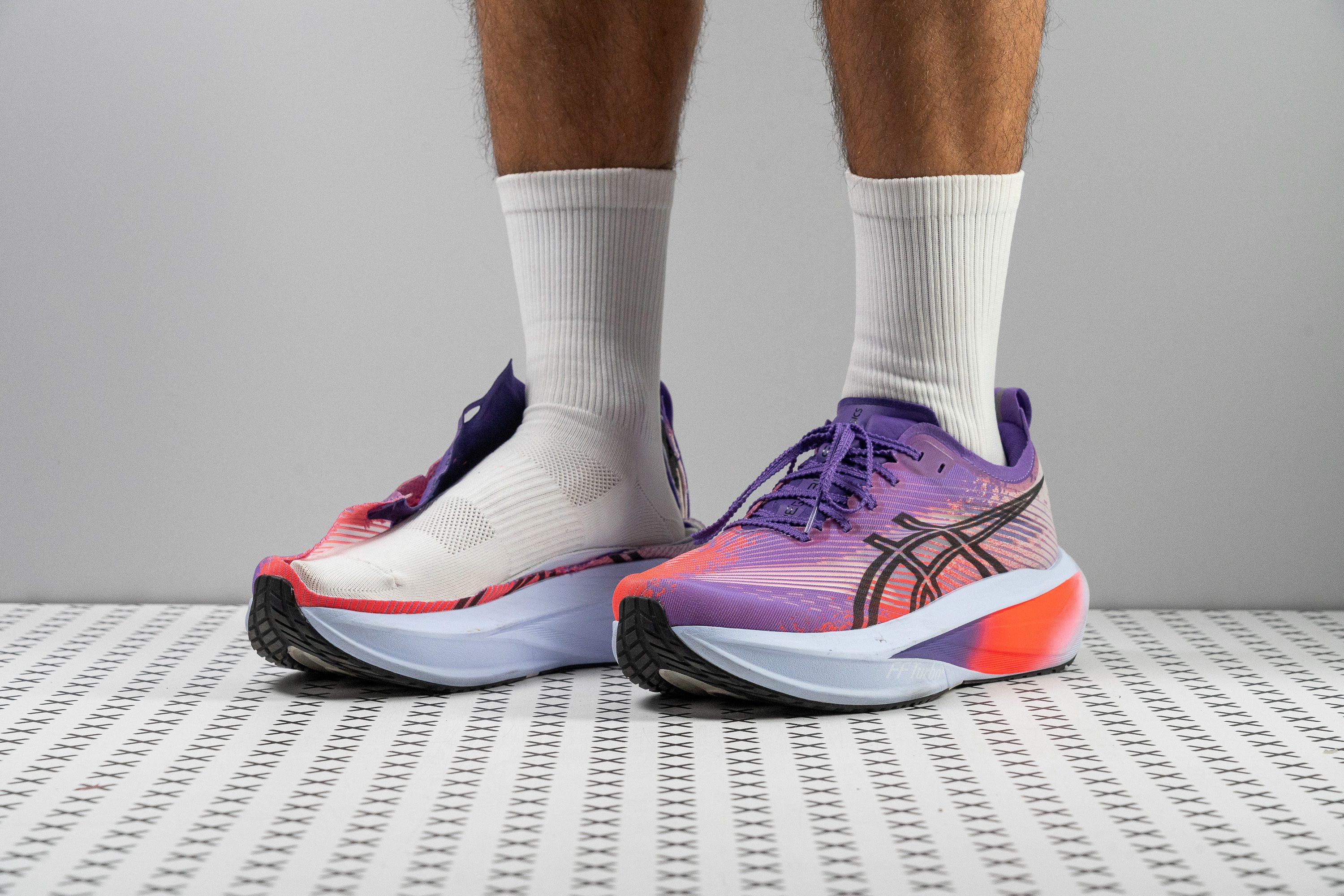
















































What makes it the best?
In our runs, the plateless Megablast emerged as our first-class ASICS super trainer with its dynamic midsole and next-level comfort and reliability. There’s so much to praise about this shoe, but its exceptional responsiveness, shock absorption, and grip blew us away in the lab. It’s tailored for all kinds of training, regardless of distance or pace, with its maximum energy in a lightweight build.
The responsive mega-stack delivers effortless speed and comfort. Our calliper reveals a massive 45.1/35.2, among the tallest we’ve ever encountered in the lab. Testing for its energy return, the heel recorded 73.0% and the forefoot a massive 73.8%, ensuring we won’t run out of power with each stride.
Besides the responsive midsole, it’s easy to manoeuvre because of its light build. For its size, its 7.8 oz (218g) construction is awe-inspiring, managing to stay 21.6% below the average running shoe. The landing that follows every takeoff is pure bliss, as the pillowy cushion absorbs impact. We verified this in our shock absorption test with record-breaking scores of 160 SA (heel) and 144 SA (forefoot).
We observed the presence of the ASICSGRIP rubber in the outsole, giving us high hopes. Indeed, the outsole scored 0.80 in our traction test, which means it exhibits 70.2% stronger grip than average. No need to doubt running through fast corners and wet streets, the Megablast can handle them all!
However, this remarkable trainer is not for budget-conscious buyers with its £220 price tag. But honestly, we think its elite performance is worth the investment compared to the average £140 trainer.
Pros
- Outstanding energy return
- Exceptional impact protection
- Durable, grippy outsole rubber
- Astonishingly low weight
- Performs at any pace and distance
- Breathable, lightweight upper
- High-quality materials from heel to toe
- Suitable for all footstrikes
- Top performance without a carbon plate
Cons
- Extremely expensive for a training shoe
- Limited outsole coverage
- Poor toebox durability
Best budget ASICS running shoes
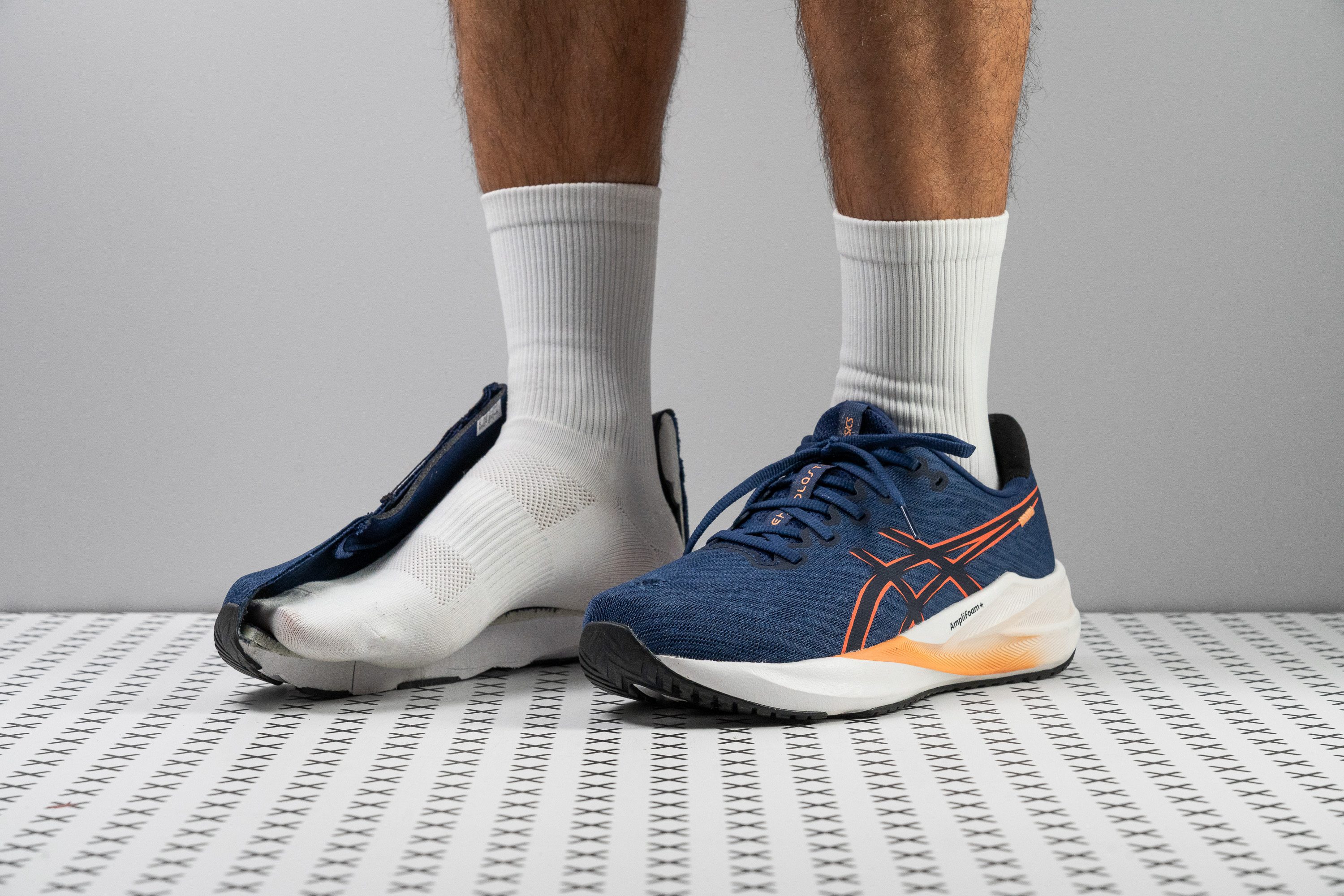













































What makes it the best?
Versablast 4 surprises us with long-run-ready comfort and a surprisingly stable yet forgiving ride. Our lab results confirm versatility is its forte, making it ideal for easy runs and daily wear. Priced at just £80 vs. the £140 average ASICS running shoe, it managed to deliver a durable outsole, earning the top-budget title for this category.
This daily workhorse feels comfortable enough for LSDs and responsive enough for speed sessions. Credit to its midsole, rising to a healthy 36.1/26.7 mm stack for impact protection, and its impressive 53.3% energy return score for its price.
We felt nimble as we sped through fast corners gracefully, thanks to its unresistant midsole that quickly adapts to our movements. Our bend test shows it’s slightly more flexible than average, needing 14.7N to reach 30 degrees.
An added appeal of this budget-friendly shoe is its robust outsole, boasting minimal damage in our Dremel test (0.8 mm vs. 1.0 mm average) and wear tests, indicating that the Versablast 4 can outlast its competitors.
However, warm weather strips away the pleasant in-shoe experience as the upper traps in heat, receiving a low 2/5 breathability score.
Pros
- Stable ride
- Cushioned for long runs
- Good performance-to-price ratio
- Ideal for beginners
- Solid outsole durability
- Great option for heel strikers
- Can be used as a casual shoe
- Inspired by Novablast DNA
Cons
- Not for summer
- Upper durability concerns
- Narrow fit
- Probably a bit heavy
How to find the best ASICS running shoes
To get the best possible experience from a pair of ASICS shoes, you need to consider the following factors:
- Terrain: Will you be running on paved roads or trails?
- Use: Daily runs, speed training, or competition?
- Cushioning: How much cushion and which type will benefit you the most?
- Arch support: Do you need more stable and supportive running shoes?
Not to mention other factors like breathability, durability, size, fit, and price. This guide will help you answer these questions and find a perfect match among ASICS shoes.
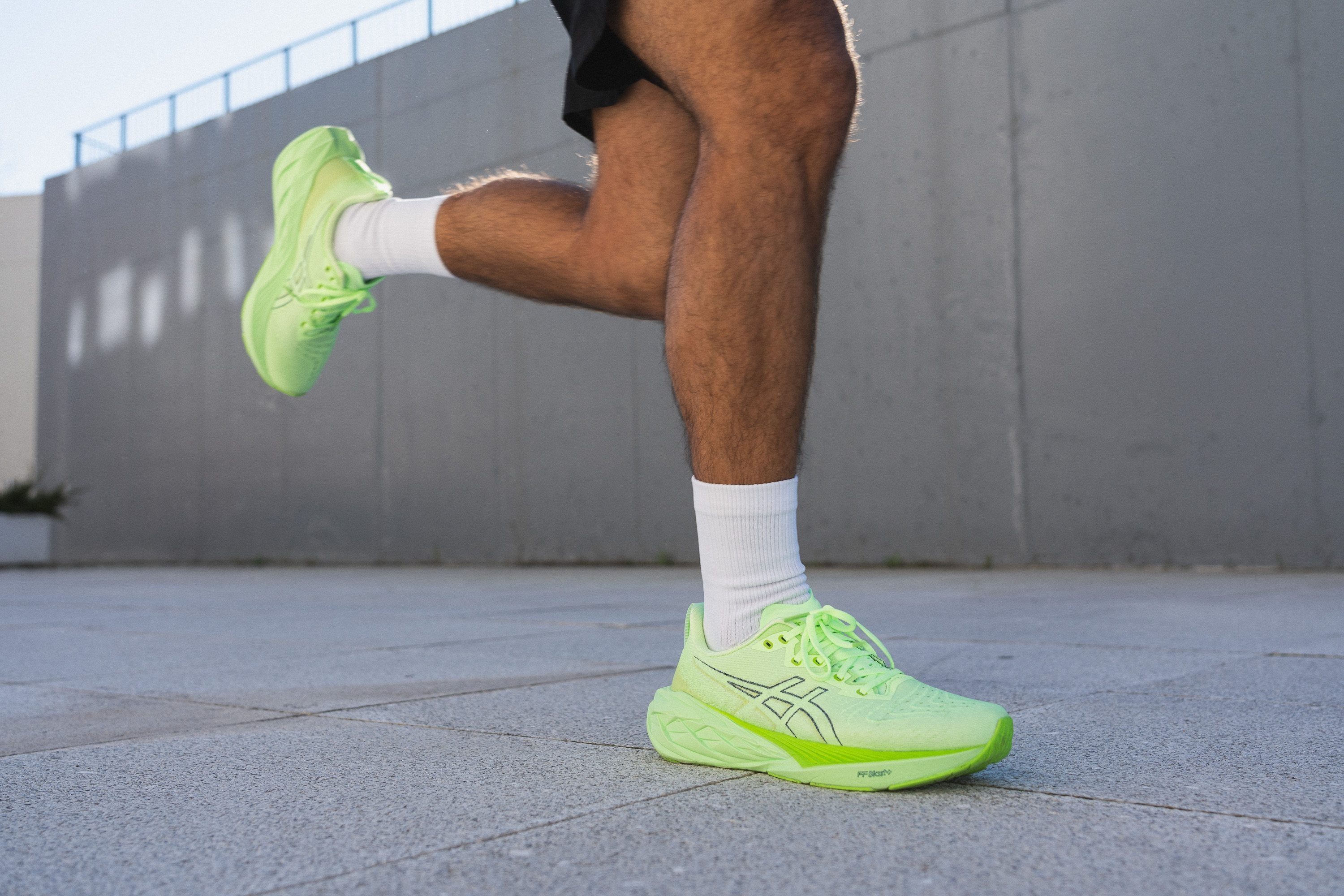
ASICS running shoes for road and trail
Gliding on paved roads is very different from traversing rocky and muddy trails. That’s why you should start by choosing the right category of ASICS shoes.
90% of the brand’s running shoes are made for road running but there are still a few solid options for going off-road.
ASICS road shoes
Designed for running on smooth roads, pavements, tarmac, and treadmill, ASICS road shoes have a lighter build compared to trail shoes. They have thinner and more breathable uppers as well as smooth rubber outsoles.
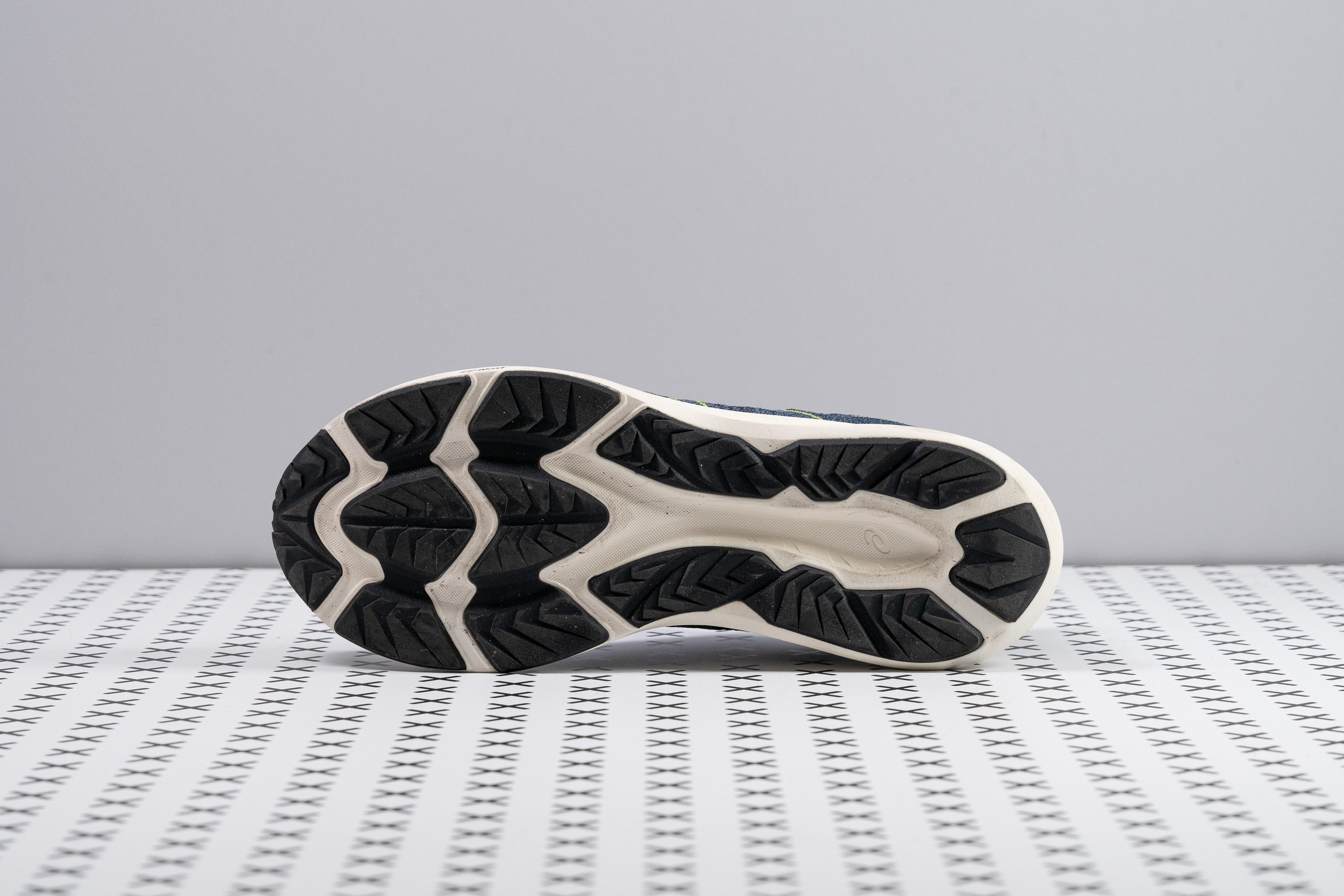
ASICS trail shoes
Trail shoes from ASICS have a more hard-wearing construction and deep lugs to tackle unfriendly terrain. They also tend to be heavier than road shoes (1.5 oz/42.5g heavier on average).

We measure lug depth on ASICS trail shoes to check their readiness for various types of terrain. Here is a quick tip:
- If lugs are 3 mm or less, the shoe is best for road-to-trail use and hard-packed trails.
- If lugs are 4 mm or more, the shoe has enough bite for mud, slush, snow, and sand.

ASICS shoes for daily miles, tempo runs, and competition
ASICS running shoes range from heavily cushioned and cosy beaters to ultra-light and carbon-plated marathon shoes.
Your running goals largely determine the type of ASICS shoe you need.
Daily running shoes from ASICS
This is the largest category of ASICS running shoes which are intended for:
- clocking up daily miles
- long and slow runs (10K or more)
- easy recovery runs
You can expect a great deal of cushioning and comfort from ASICS daily trainers. Beginner runners will also find a suitable option in this range.
Speed training shoes from ASICS
Lighter and faster than daily running shoes, speed trainers are perfect for picking up the pace during your runs. This is the right category for:
- tempo runs, fartlek, and cardio training
- training for a race
You can see that ASICS’ speed trainers are notably lighter than daily running shoes: 8 oz (225g) and 9.7 oz (275g) respectively. Studies show that with every 3.5 oz (100g) added to your running shoe, your speed goes down 1%.
That’s why it makes sense to get a speed training shoe if you’re looking to set a new personal best.
Competition running shoes from ASICS
The brand’s Metaspeed race shoes have made it to our top picks multiple times. It is a fierce competition to the record-shattering Vaporfly and Alphafly from Nike.
Packed with super foam, high energy return, and propulsive carbon plates, these ASICS shoes are ideal for setting records. You can count on them for any race distance, from 5K to a full marathon.
You can reap the benefits of a high-end ASICS race shoe if:
- you are an experienced runner
- you maintain a faster pace
- you have a forefoot/midfoot striking pattern
If you want to know exactly how carbon-plated shoes can improve your running performance, see our in-depth research on the topic.
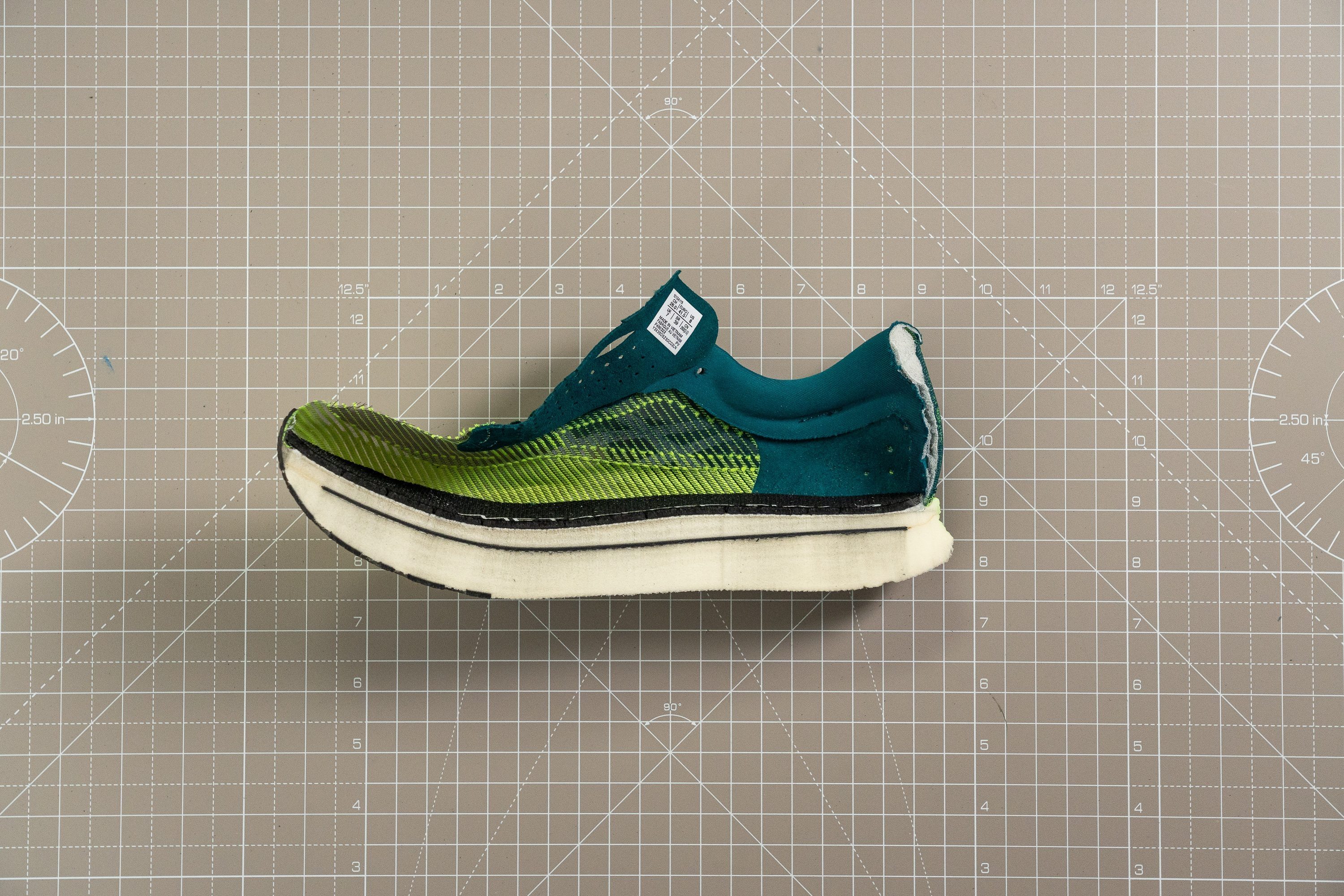
How to choose the right cushioning in ASICS shoes
You will be treated to an amazingly cushioned experience in almost every ASICS shoe you get.
But if you want a truly customised underfoot experience, there are a few factors to consider:
- heel stack (the amount of material between the heel and the ground)
- heel-to-toe drop (the difference in midsole thickness between the heel and forefoot)
- cushioning foam (shock absorption, softness, and energy return)
Heel stack height
As a leading manufacturer of running shoes, ASICS does not skimp on cushioning.
We haven’t come across an ASICS shoe with less than 30 mm of heel stack. And some of the tallest platforms reach as high as 42.7 mm in the heel!
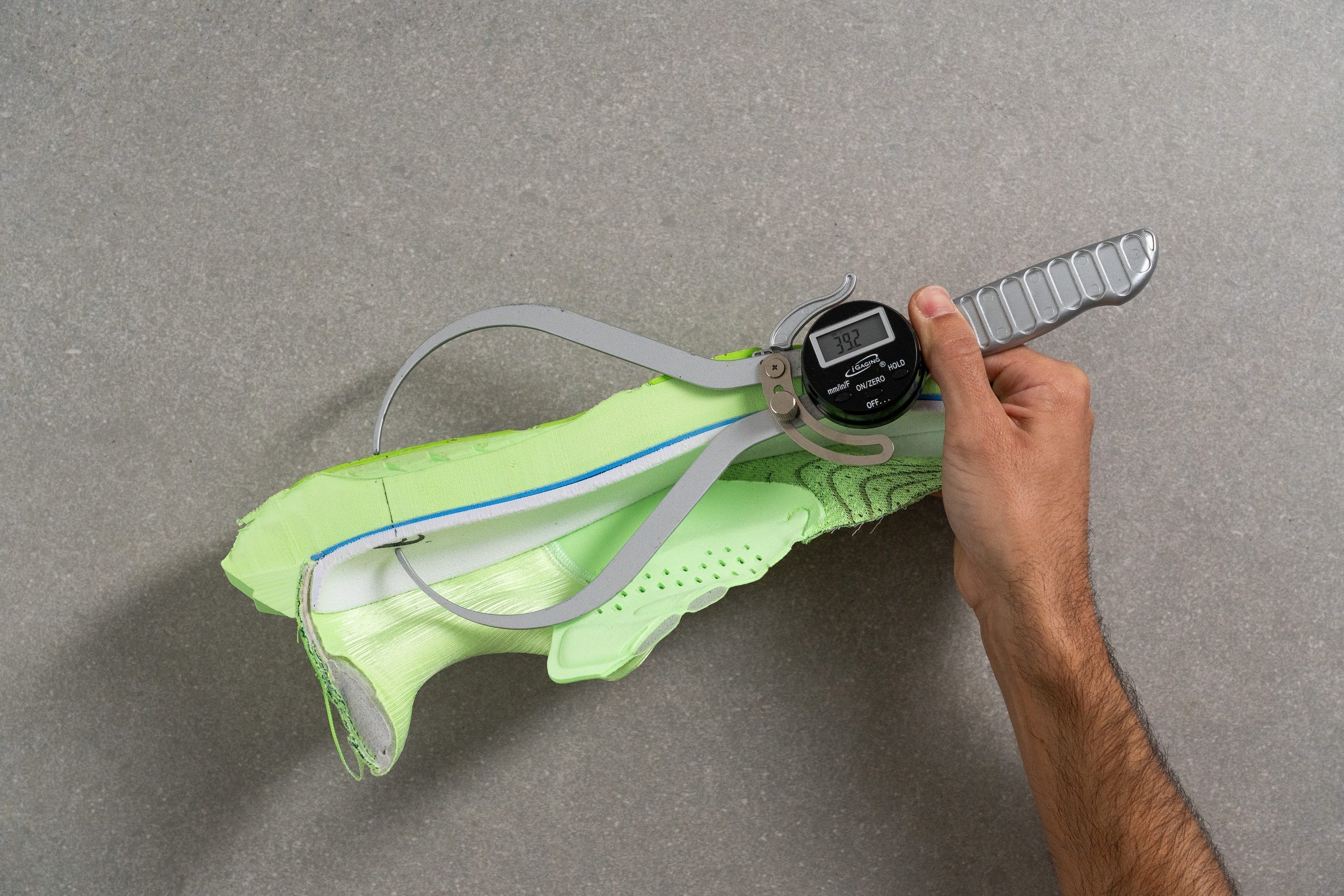
As a beginner, you may be enticed into getting the thickest midsole. However, research shows that runners who are new to max-cushioned shoes are at risk of amplified impact loading, leg stiffness, and even injury.
To avoid potential stress and strain, we recommend that beginner runners go for the moderate heel stack of 30-35 mm.
ASICS shoes with heel stack above 35 mm offer plenty of cushioned support for running long distances (10K and above).
Heel-to-toe drop
Most ASICS shoes have an average heel-to-toe drop which is suitable for 90% of runners, beginners included.
Ranging from 8 to 12 mm, this setup is ideal for runners who strike the ground with their heels first.

If you are a forefoot or midfoot striker, stick to ASICS shoes with a drop lower than 8 mm. Or consider getting a daily trainer from Hoka as it has options with a drop of 5-6 mm.
To learn more about the effect of heel-to-toe drop on the runner’s performance, see our comprehensive guide.
Cushioning: softness, shock absorption, and energy return
Depending on what kind of underfoot experience you are looking for, ASICS offers a wide range of cushioning foams:
- firm and stable (AmpliFoam)
- ultra-light and soft (FlyteFoam)
- light, soft, and bouncy (FlyteFoam Blast)
- light, firm, and incredibly bouncy (FlyteFoam Turbo)
Here is a more detailed overview of each foam as well as ASICS running shoes that use them. The table is sorted by the category of foam - from basic (cheap) to premium (expensive).
|
Foam |
Used in |
Characteristics |
|
AmpliFoam |
Pulse Excite Contend |
|
|
FlyteFoam |
Noosa Tri GT 1000 |
|
|
FlyteFoam Blast/Blast+ |
Novablast Nimbus Cumulus Kayano GT 2000 Magic Speed Dynablast |
|
|
FlyteFoam Blast Turbo |
Metaspeed Sky Metaspeed Edge Superblast |
|
Learn more nuances about running shoe foams in our extensive guide.
In our lab, we measure the foam softness of each ASICS running shoe precisely using an HA durometer. The lower the reading, the softer the foam.
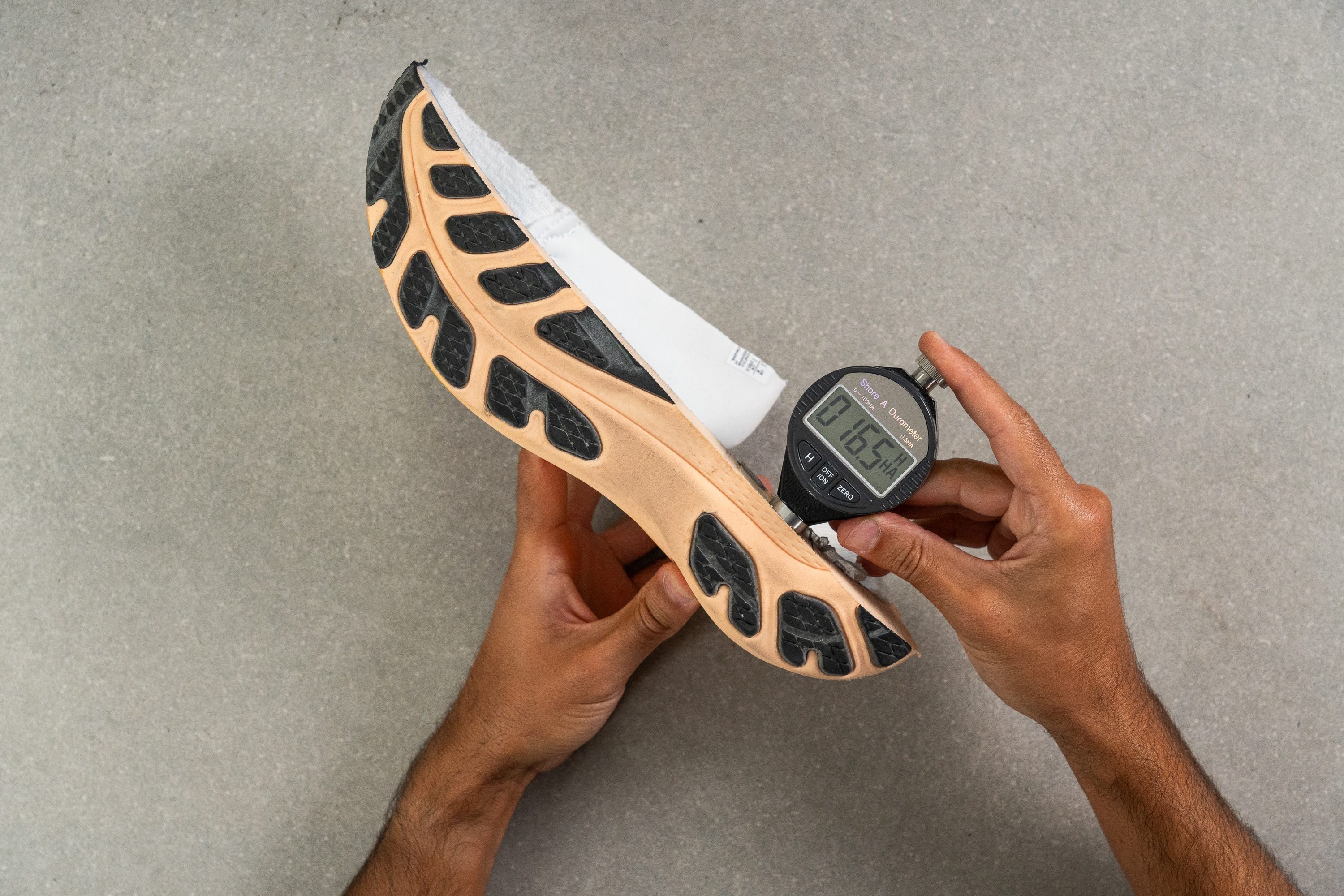
But, the decision on softness is not enough.
The full story about the midsole is told when we also learn about its:
- shock absorption, the ability to reduce the impact forces so that the midsole absorbs some of them instead of runner's legs
- energy return, the ability of the midsole to bounce back after it was squished at the landing, so that the runner is greeted with the same or close to the original stack height on the next landing. Any other scenario would lead to unnecessary extra work that leads to early muscle exhaustion.
To measure the shock absorption and energy return, we follow the ASTM F1976-13, which is widely regarded as a golden standard for this testing. We basically measure energy returned vs energy absorbed and shock attenuation (force transmitted).
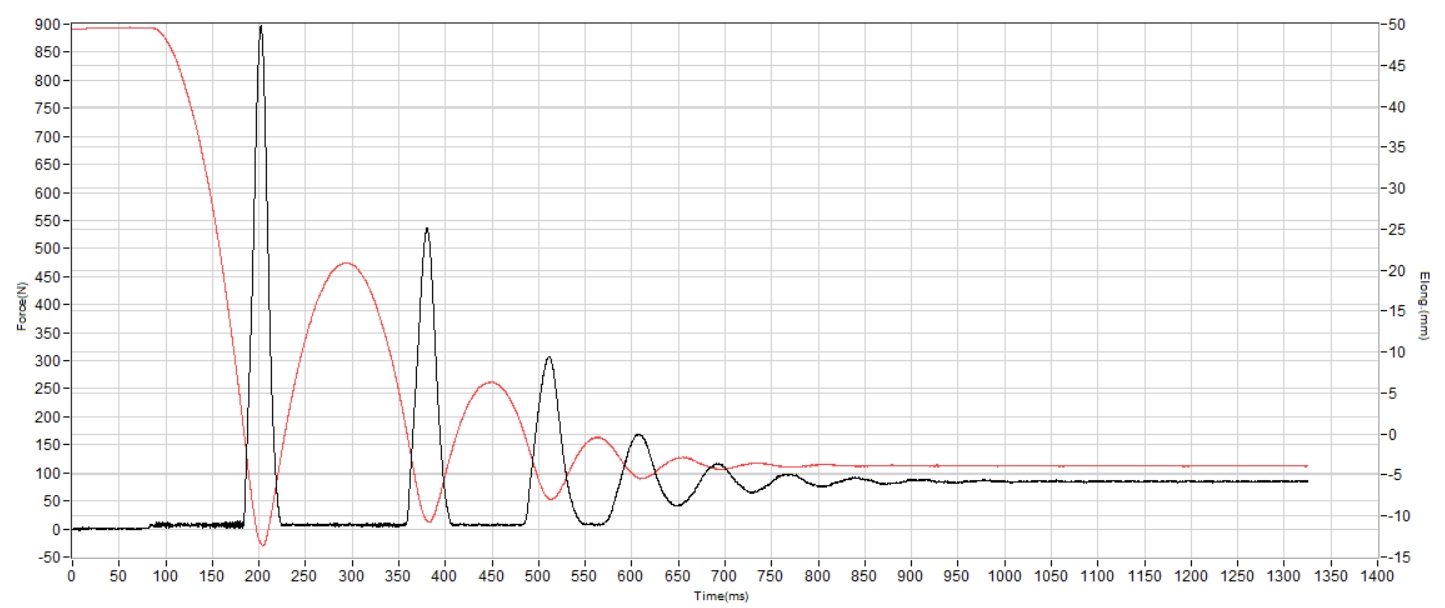
Depending on where you land, you can look at our shock absorption test results at the heel or at the forefoot.
When it comes to energy return, just like with shock absorption, the higher the better. Record-high energy return is most often found in race shoes.
Where is ASICS Gel?
The brand’s renowned Gel technology is evolving into PureGel. Unlike the original, it is now hidden inside the shoe’s midsole. Placed under the heel, it is just as effective in providing impact protection but is claimed to have 4% more energy return and to be 65% softer than the original Gel.
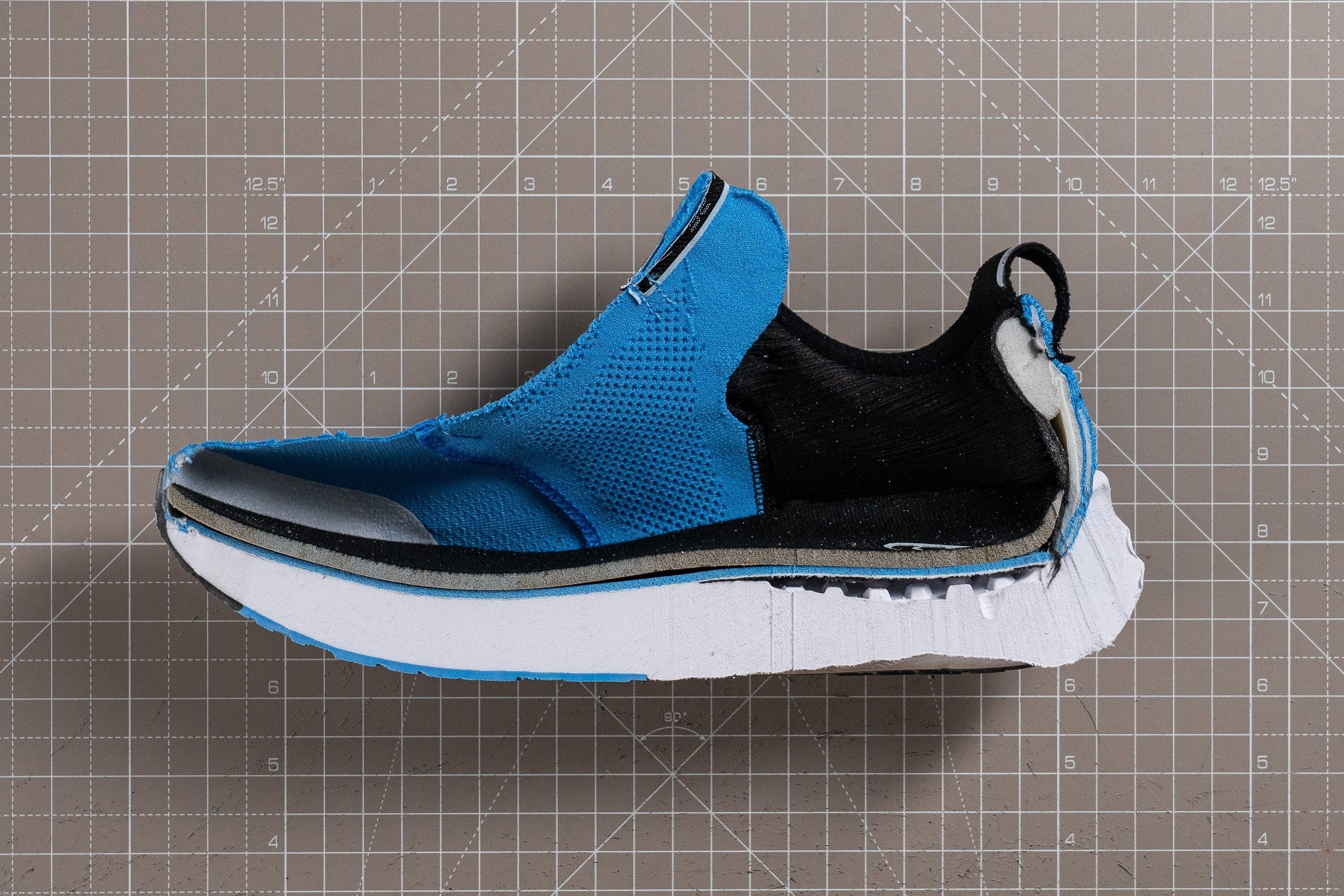
Arch support in ASICS running shoes
ASICS is one of the most trusted footwear brands when it comes to conditions like:
- flat feet (low arches)
- overpronation (excessive inward rolling of the feet and ankles)
If you are not sure about your case, we recommend consulting a podiatrist or checking our guide on pronation. Also, one quick way to tell if you need supportive footwear is when your shoes wear out faster on the inner side.
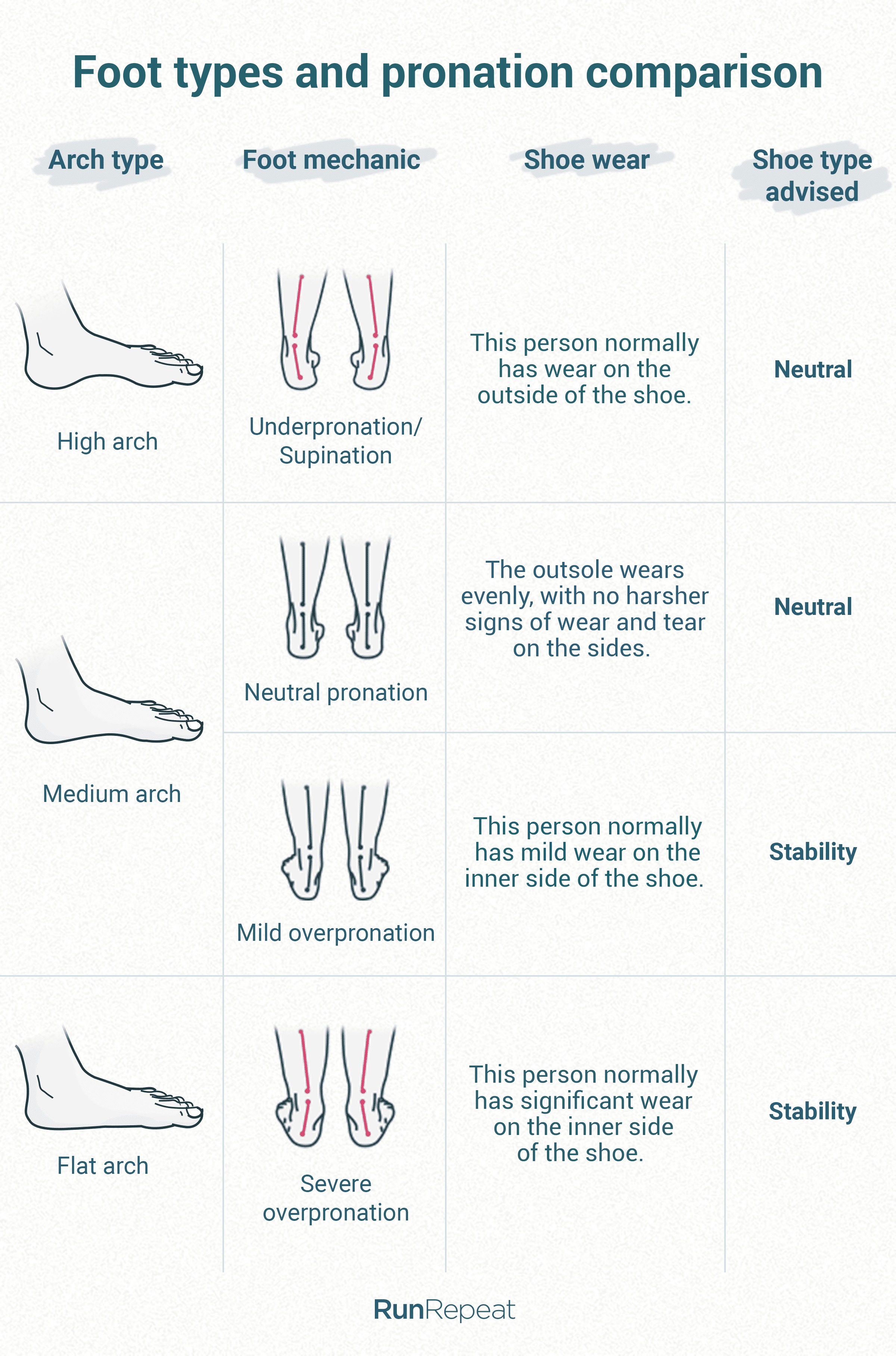
Some running shoes from ASICS are packed with stabilising components that help to keep the gait straight, preventing discomfort and potential injuries.
As opposed to bulky and stiff stability shoes of the past, ASICS proves that you can have a plush and buttery smooth ride alongside arch support. This is achieved by:
- targeted use of firmer foams
- structured heel counters
- wide platforms
We measure and assess each of these parameters in our lab to give you an overview of the most stable ASICS running shoes. The table below is sorted by the level of support (most supportive first).
Torsional rigidity and heel counter stiffness are assessed on a 1-5 scale, where 5 is the stiffest. Midsole width is measured at the widest points of the heel and forefoot using a calliper.
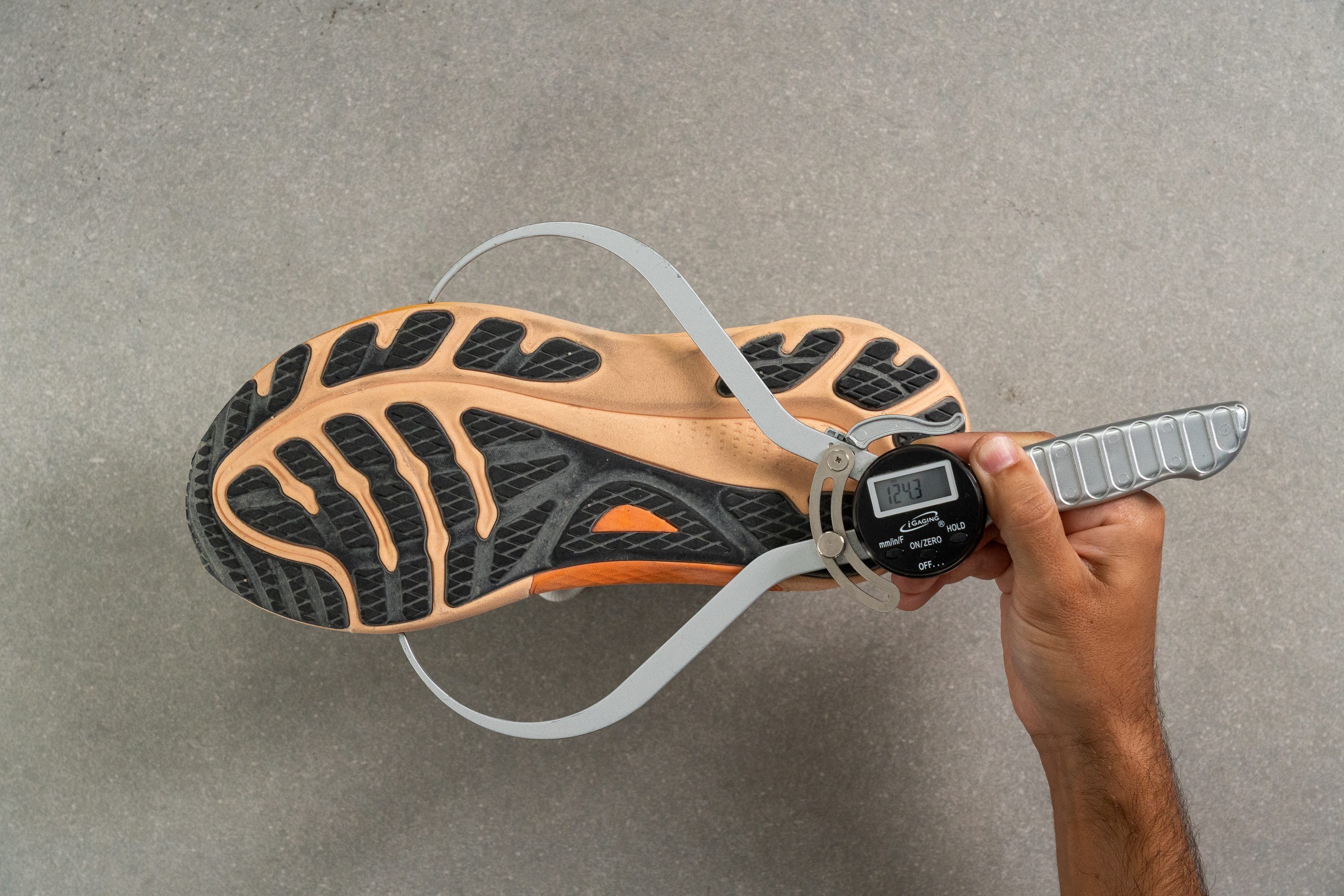
As you can see from the table, more supportive shoes come with a bit of a weight penalty. But you can opt for a little less support in favour of a lighter shoe.
Size and fit of ASICS running shoes
More often than not, ASICS shoes are predictable in their size and fit. The brand’s size chart is also consistent with other major brands like New Balance, Brooks, and Saucony.
But if you’re coming from Nike or Adidas, sizing down may be necessary.
| Foot length (mm) | ASICS | Nike | Adidas |
| Men's US sizes | |||
| 260 | 8 | 9 | 8.5 |
| 270 | 9 | 10 | 10 |
| 280 | 10 | 11 | 11 |
| Women's US sizes | |||
| 230 | 6 | 6 | 6.5 |
| 240 | 7 | 7.5 | 7.5 |
| 250 | 8 | 8.5 | 8.5 |
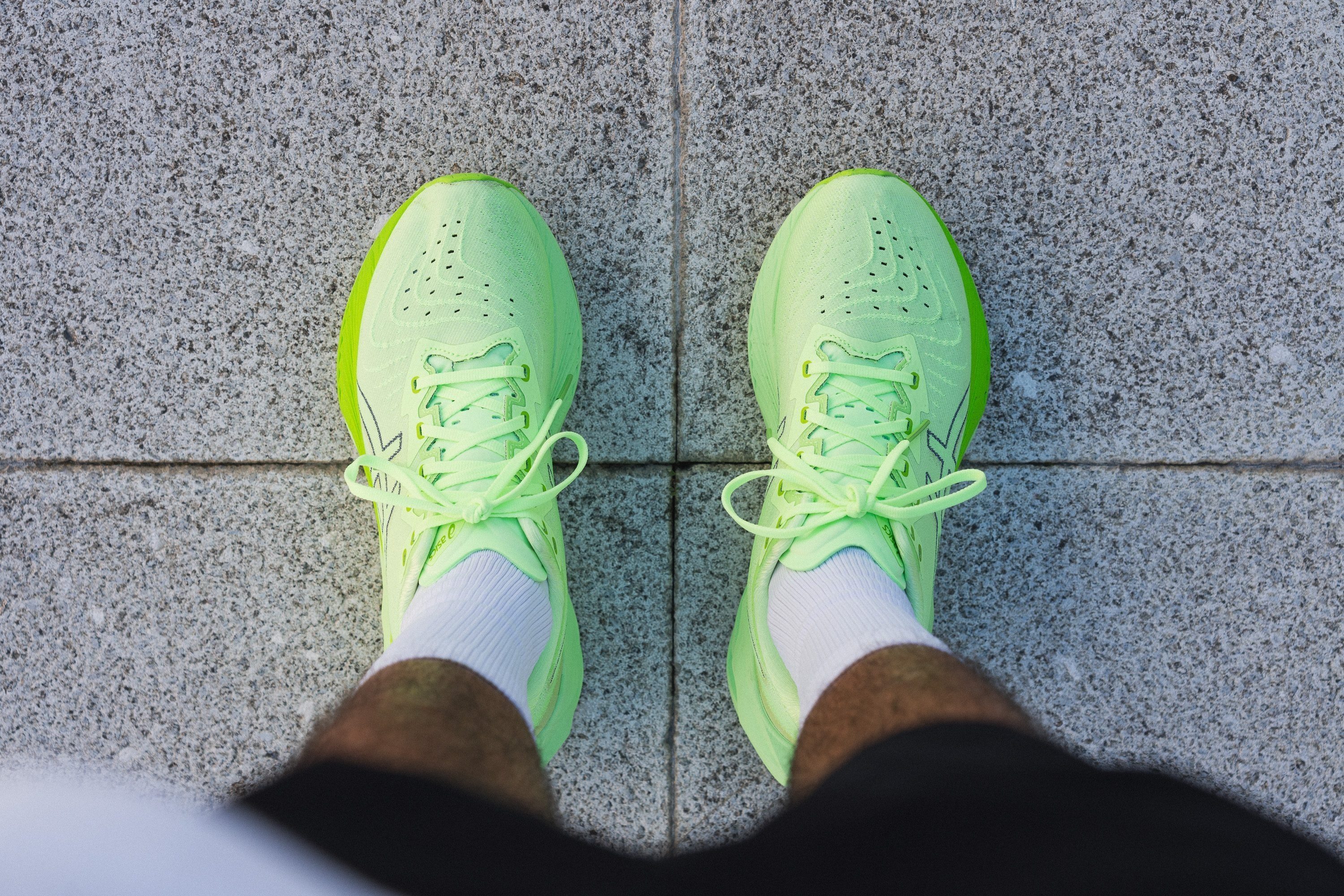
If you’re getting your very first pair of ASICS shoes and you don’t have the option to try the shoe in person, we highly recommend:
- measuring your foot length (follow this guide)
- checking ASICS’ official size chart (link)
It is just as important to consider the width of your future pair. Luckily, ASICS is one of those brands that takes good care of runner’s feet by offering multiple widths for its models.
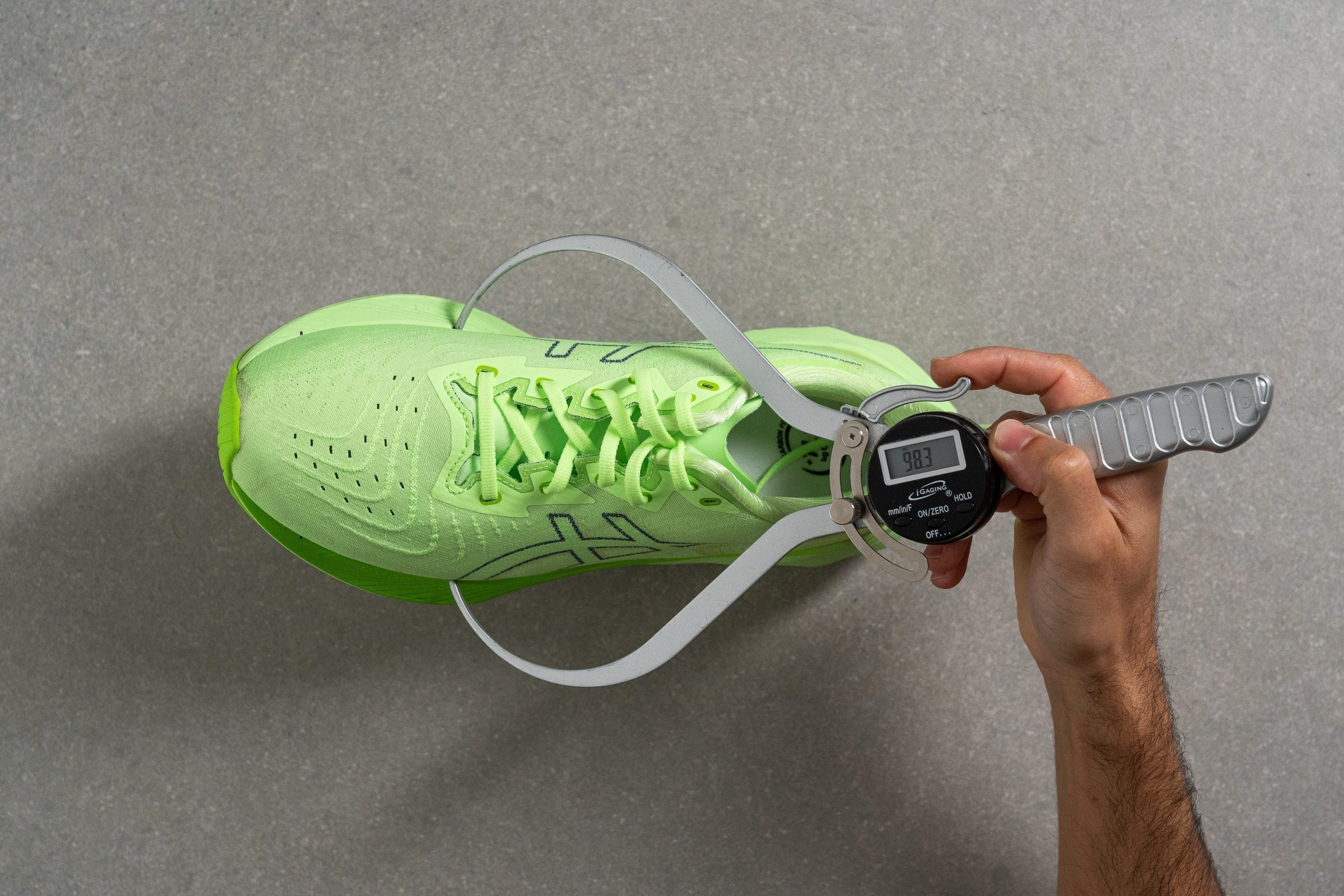
Are ASICS running shoes breathable?
ASICS shoes hardly ever disappoint us in the breathability department. On a 1-5 scale, where 5 is the most breathable, the brand’s running shoes average at 4.
Only 30% of ASICS shoes got a score below 4.
Here is the overview of the most breathable ASICS running shoes for your summer runs, based on our thorough lab tests:
Are ASICS running shoes durable?
As far as road running shoes go, ASICS shows average results when it comes to durability. Most running shoes from this brand are expected to last the regular 300-500 miles.
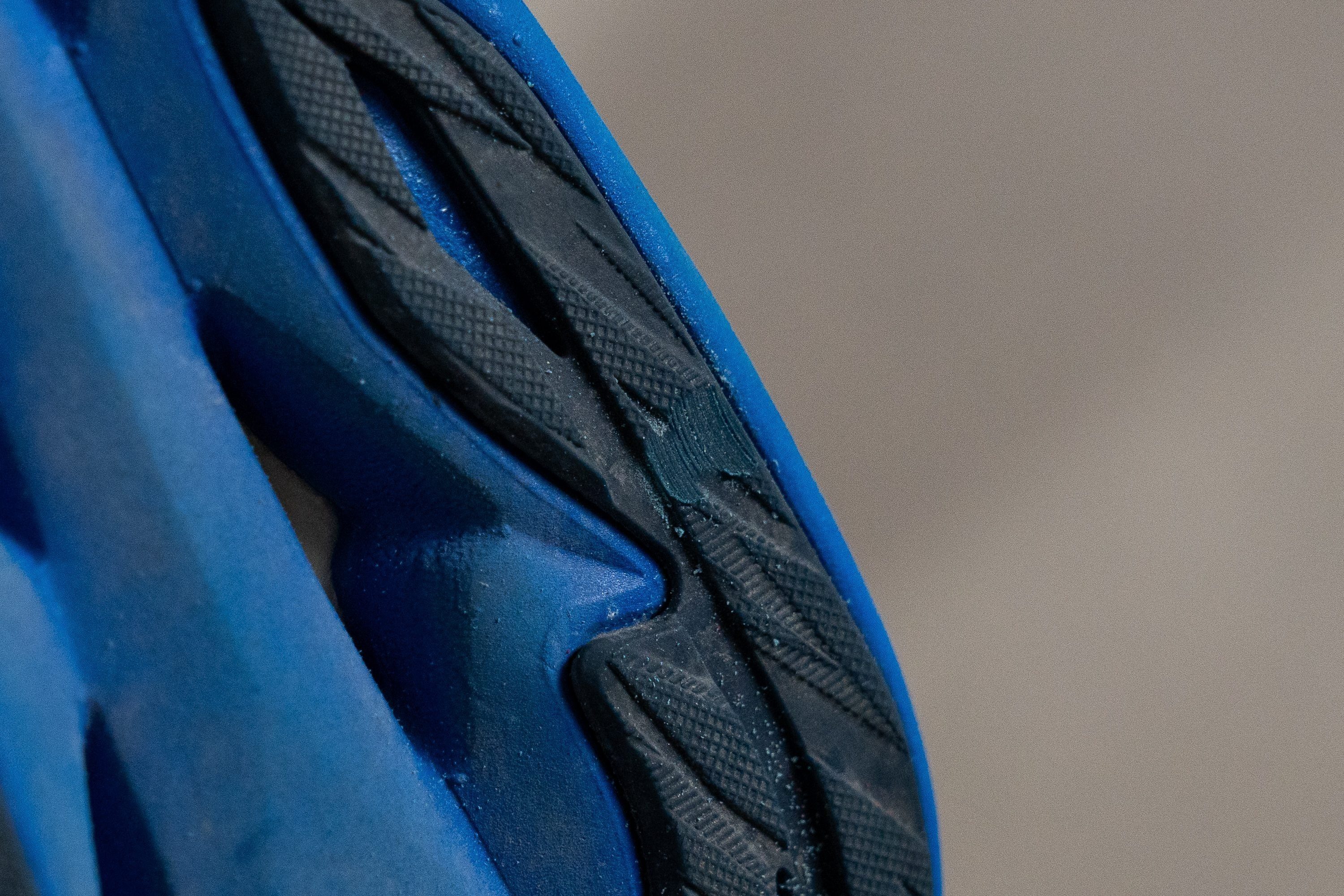
Unless we’re talking about the magical AHAR outsole! This rubber compound consistently shows impressive results in our durability tests. That’s why the outsole is usually the very last part of ASICS shoes to give up.
We measure outsole durability by the depth of the dent that appeared in the rubber after 22 seconds of drilling. Here is the overview of ASICS shoes with the most durable outsoles:
The smaller number indicates a more durable rubber.
The uppers of ASICS running shoes aren’t as hard-wearing as the outsoles. They give up sturdiness in return for lightness and breathability.
But if you’re wondering, here is the list of ASICS shoes with most durable uppers:
Rated on a 1-5 scale, where 5 is the most durable.
Price of ASICS running shoes
The average price of the currently available ASICS running shoes is £140. This is on par with other popular brands like Nike, Adidas, and New Balance.
ASICS has a lot of affordable options within the £60-100 range. But if you’re looking for the best performance, we recommend looking at soes with an MSRP of £130-160.
Finally, the brand’s elite race shoes come in at £250 which is a standard price for this category these days.
